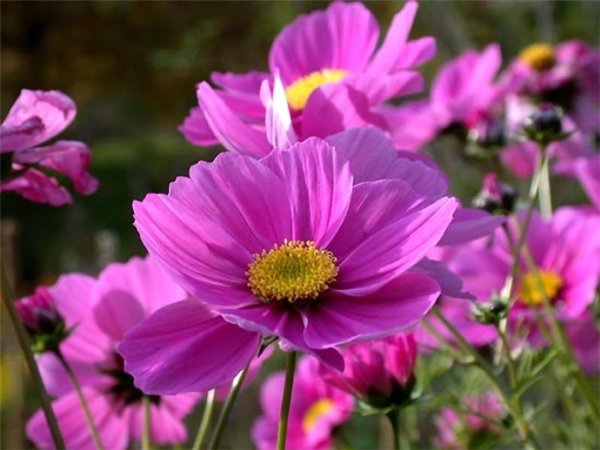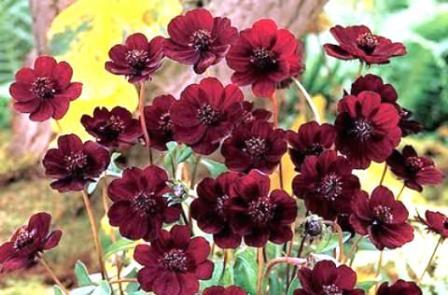 Today we learn what cosmea is, growing from its seeds, when to plant even seeds in the ground, even for seedlings. Cosmea is also good because it can be easily planted in the fall, by the end of November, and in the spring it will rise early, because it is not afraid of colds and will bloom early.
Today we learn what cosmea is, growing from its seeds, when to plant even seeds in the ground, even for seedlings. Cosmea is also good because it can be easily planted in the fall, by the end of November, and in the spring it will rise early, because it is not afraid of colds and will bloom early.
You can throw seeds into the ground in spring, but then it will bloom later, in about July, or you can plant seedlings, and in June you will already get a beautiful color of a gentle unpretentious flower.
If you land a cosmea on your plot, you will not have to bother to propagate it especially troublesome. The Mexican beauty herself will be sown for several years in a row, and you just have to thin out it, and, if you wish, transfer it to a new place of residence. Cosmea has a number of advantages, and is suitable for absolutely everyone for growing - both for professionals and beginners, in poor and rich buds, in the sun and partial shade, on home lawns, in gardens and in office areas.
More interesting: when to plant pepper for seedlings in 2016.
Landing
Planting this unpretentious and delicate flower is not at all difficult. Dig a flower bed in an open sunny area in early spring, scatter seeds around the surface with heaps of 3-4 seeds about every 30 cm, and simply stick with your palm to press it into the ground. And all - you can wait for seedlings. Your plants planted in this way will give flowers by the end of July, and will bloom until September. And in order to get flowers back in June, you need to grow cosmea seedlings. You can combine two methods, and thus your cosmea will bloom from June to September, replacing one another.
Seedling planting
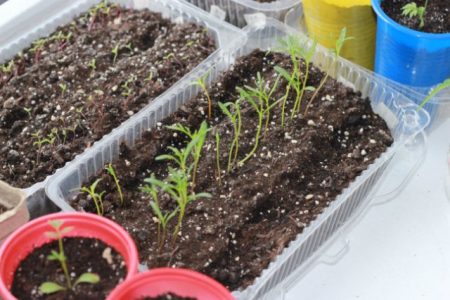
More reliable results and faster flowering can be obtained by planting seeds in boxes in the month of March, maximum in April, filling containers with slightly warm soil, sowing seeds from above, also slam with a palm, cover with a film and expose in the sun. If the seedlings sprout densely, they need to be thinned out, leaving 10 cm between the shoots, you can also transplant (dive) them into different glasses. You can still do this - immediately take the glasses and plant 2-3 seeds in them, so that they do not bother with picking.
When it’s already warm, the zemlyotska will warm up, by the end of May - to plant stronger sprouts in the ground, leaving a distance of about 35 cm between them so that the bushes do not interfere with each other. If you grow a tall kosmey, then you need to take care of the support immediately, because its stems are thin, and they themselves will not hold. When the bushes grow to 50 cm - you need to pinch the top - so you will allow the bush to expand in breadth. Thus grown cosmea will bloom in June.
Landing under the winter
Not a bad option, as we mentioned above - to plant cosmea in the winter. For this, the strawberry is digged in, fertilizers are applied, all roots, weeds are removed, and seeds are planted. But - you must definitely calculate the time precisely in your region, because the seeds should not germinate in any way before the frosts come, otherwise the seedlings will simply freeze. Usually the optimal time is the end of November, but you need to navigate the area.
See also: Gardens of Russia - Raspberry Miracle.
The soil
As we have already specified, cosme almost any soil is suitable, but - on too greasy it will all go into the foliage and it is unlikely that you will see much flowering, on too poor the color will crush and the bushes will fade. Optimum - light drainage soil, with an average nutrient content.
Cosme care
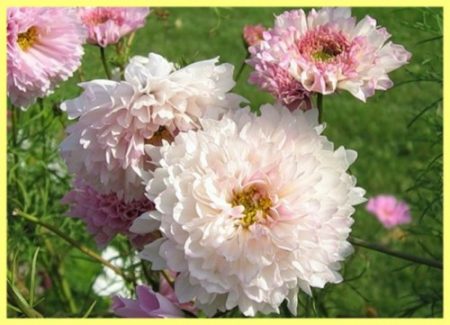
It is necessary to water the plant sparingly, because it does not like waterlogging, and tolerates drought in general quite calm.While the plant grows and grows stronger, it is watered more often, and as soon as it enters into force, rare rains are enough for it to survive, but it’s better not to keep it in extreme conditions.
When the cosmea enters the color, it is necessary to remove the flower stalks that have departed on time, feed them with organic and minerals 3 times a season, and it would be nice to spray the bud for plentiful flowering. If the beauty grows very much - it is quite possible to cut, lead to a beautiful shape.
Diseases, pests
This flower is so unpretentious, so resistant to pests that you are simply amazed. She’s not afraid of anything, she’s practically not affected by anything, dear, except that the slugs can bother her - so they just need to be collected in traps (put cans of beer, and snails with slugs willingly crawl there to regale).
After flowering
If you planted an annual cosmea, as we have already said above, it can also propagate by self-sowing, and you can collect seeds from boxes and store them for up to 5 years in the house. If you need to collect seeds, select the strongest and strongest buds, put gauze covers on them, otherwise the seeds will fly apart or the birds will eat, for them this is a treat.
As for perennial cosmea, it enters into force with age, the bushes become strong, and it is possible to plant it with cuttings completely by dividing tubers. When the perennial fades, cut it to 15 centimeters - so all the power will go to the root after flowering, and not be squandered on empty stems that are no longer needed. In winter, it is better to cover the bushes warmer, for example, with spruce branches.
See also: petunia - when to plant for seedlings in 2016.
Advice:
- With the seedling method of growing, thin out the seedlings when they enter into force and grow to at least 10 cm. Leave the distance between the plants to about 40 cm.
- As top dressing, you can use organic matter in the form of manure, mineral water in the form of nitrophosphate and gum. To add little by little, an excess of nutrients threatens the growth of the leaf part to the detriment of flowering. Moreover, top dressing should be divided into 3 times - when the buds are still beginning to form, when they have already entered into force, and when they started to bloom.
- If you planted seeds, all sprouted densely, you can do this: remove the weakest, and those that have grown strong can simply be moved away and form a flower bed from them, it would be nice to plant them among other flowers, they form a beautiful flower garden.
Species and varieties
There are now more popular types of cosmeas that gardeners plant with great pleasure, for example:
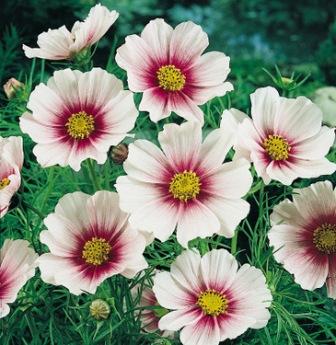
Cosmea twice-feathered- annual, usually in Mexico it grows in mountainous regions, with delicate pink or red flowers, reaching up to 1.5 meters. In appearance, the bushes are similar to dill plants, large inflorescences, with a bright color inside the flower.
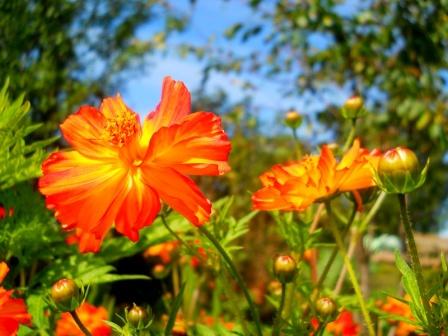
Cosmea sulfur yellow - this guest from America came to us, is thermophilic, can grow up to 1.5 meters in height too, there are types of lemon yellow like Grest Lemon or orange saturated like Bilbo.
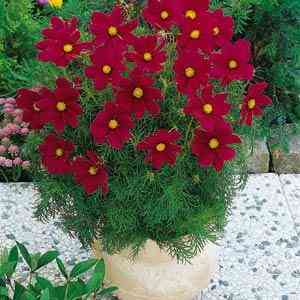
Blood red - Another garden favorite, Mexican guest. Sometimes her flowers are saturated with red all the way to black, which is why she got the second name - black. This kind of cosmea is preferable to grow in pots, because it is painfully thermophilic, and for the winter to bring pots into the house. When grown in soil in the southern regions for the winter, it still needs to be well covered.
Read more: garden for lazy people - Good advice will be provided to you.

